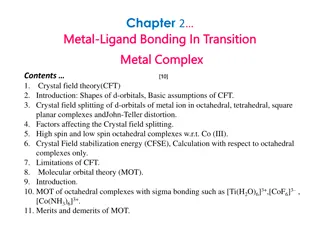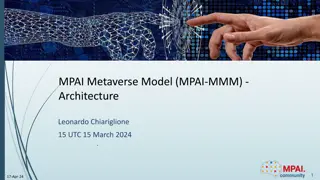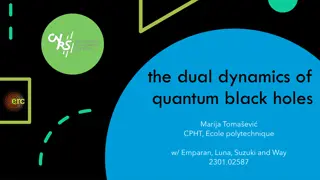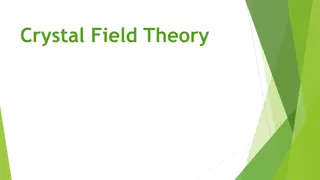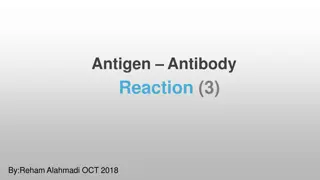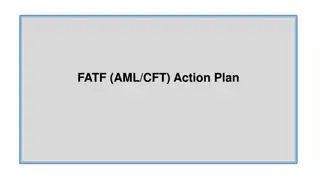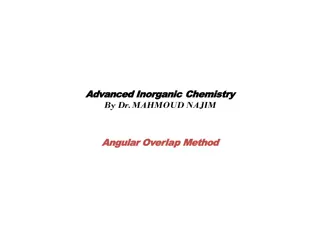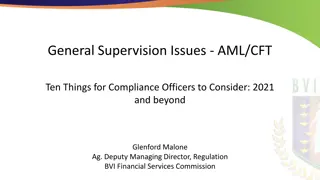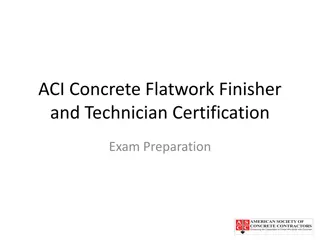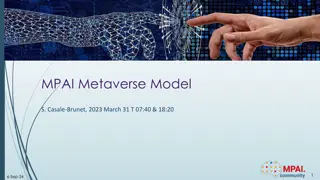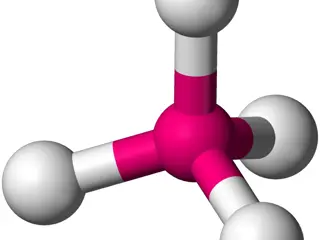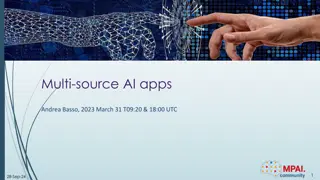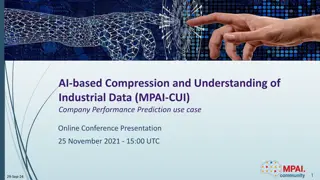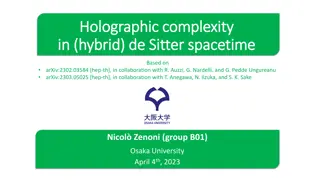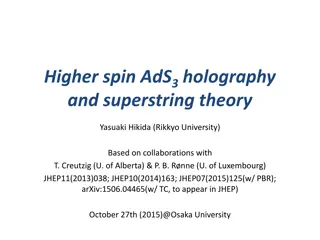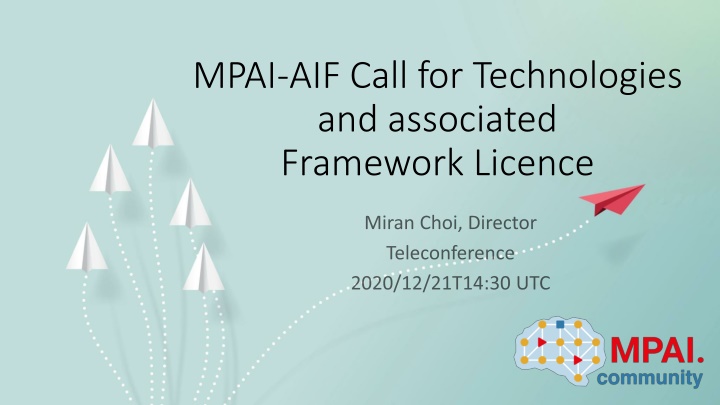
MPAI-AIF AI Framework Standard and Development Process
"Discover the MPAI-AIF's initiative to develop AI-enabled data coding standards, the importance of AI technologies in modern industries, and their rigorous standard development process. Learn how an AI Framework standard can streamline implementation of AI-based modules across diverse applications."
Uploaded on | 0 Views
Download Presentation

Please find below an Image/Link to download the presentation.
The content on the website is provided AS IS for your information and personal use only. It may not be sold, licensed, or shared on other websites without obtaining consent from the author. If you encounter any issues during the download, it is possible that the publisher has removed the file from their server.
You are allowed to download the files provided on this website for personal or commercial use, subject to the condition that they are used lawfully. All files are the property of their respective owners.
The content on the website is provided AS IS for your information and personal use only. It may not be sold, licensed, or shared on other websites without obtaining consent from the author.
E N D
Presentation Transcript
MPAI-AIF Call for Technologies and associated Framework Licence
Why MPAI? Over the past 3 decades, media compression standards have allowed manufacturing and services to boom However, the technology momentum is slowing AI technologies offer more capabilities than traditional technologies, and can be applied to data other than audio/video AI is a field supported by a global research effort Recently, industry has suffered from FRAND s inadequacy to deal with the tectonic changes of technology-intensive standards
What is MPAI? A non-profit, unaffiliated and international association that develops Standards for AI-enabled data coding Technologies that facilitate integration of data coding components in ICT systems and Associated clear IPR licensing frameworks. MPAI is the only standards organisation that has set AI as the key enabling technology for data coding standards Current MPAI members Coming from 15 countries, and industry, research and academia Representing a broad spectrum of technologies and applications
MPAIs standard development process Acr UC Use cases Name Description Collect/aggregate use cases in cohesive projects applicable across industries Identify the functional requirements the standard should satisfy Functional Requirements Commercial Requirements Call for Technologies Standard development MS MPAI standard Complete standard and obtain declarations from all Members FR CR Develop and approve the framework licence of the standard CT Publish a call for technologies supporting the functional and commercial requirements Develop standard in an especially established Development Committee (DC) SD Transitions to a new stage are approved by the General Assembly
MPAI-AIF Functional Requirements Andrea Basso Chair, MPAI-AIF Development Committee (AIF-DC)
Why an AI Framework standard? Use cases for disparate applications can be implemented with a combination of AI-based modules concurring to the achievement of the intended result If incompatible implementations of modules are put to the market, costs will multiplyat all levels and mass adoption of AI tech will be delayed AI Modules (AIM) with standard interfaces, combined and executed within an MPAI-specified AI Framework, will reduce overall design costs and increase component reusability Horizontal markets of competing implementations of AIMs with standard interfaces promote adoption and incite progress of AI tech
The MPAI-AIF Model and Components Management and Control Management and Control Execution Execution AIM AIM AIM AIM Communication Inputs Outputs AIM AIM AIM AIM Access Communication Storage Communication Access Storage Management and Control Execution AI Modules Communication Storage Access
MPAI-AIF Requirements/1 1. General Machine Learning and/or Data Processing life cycles with the possibility to 1. instantiate-configure-remove 2. dump/retrieve internal state 3. start-suspend-stop 4. train-retrain-update 5. enforce resource limits 6. implement auto-configuration/reconfiguration of ML-based computational models of single AIMs and 1. initialise the overall computational model 2. instantiate-remove-configure AIMs 3. manually, automatically, dynamically and adaptively configure interfaces with Com- ponents 4. one- and two-way signal for computational workflow initialisation and control of combinations of AIMs
MPAI-AIF Requirements/2 2. Application-scenario dependent hierarchical execution of workflows 3. Topology of networked AIMs that can be synchronised according to a given time base and full ML life cycles 4. Supervised, unsupervised and reinforcement-based learning paradigms 5. Computational graphs, such as Direct Acyclic Graph (DAG) as a minimum 6. Initialisation of signalling patterns, communication and security policies between AIMs 7. Protocols to specify storage access time, retention, read/write throughput etc. 8. Storage of Components data 9. Access to 1.Static or slowly changing data with standard formats 2.Data with proprietary formats
MPAI-AIF Requirements/3 Support implementation of AI Frameworks featuring 1. Asynchronous and time-based synchronous operation depending on application 2. Dynamic update of the ML models with seamless or minimal impact on its operation 3. Time-sharing operation of ML-based AIMs shall enable use of the same ML- based AIM in multiple concurrent applications 4. AIMs which are aggregations of AIMs exposing new interfaces 5. Workflows that are a mixture of AI/ML-based and DP technology-based AIMs. 6. Scalability of complexity and performance to cope with different scenarios, e.g. from small MCUs to complex distributed systems Without inhibiting creation of MPAI-AIF profiles.
Submitting a response to MPAI- AIF CfT Panos Kudumakis
Who can submit 1. All parties, including non members, who believe they have relevant technologies are invited to submit proposals. 2. Responses submitted to secretariat who acknowledges via email. 3. Technologies must 1. Support the requirements of N74 2. Be released according to the MPAI-AIF Framework Licence (N101) if selected by MPAI for inclusion in MPAI-AIF. 4. MPAI will select the most suitable technologies on the basis of their technical merits for inclusion in MPAI-AIF. 5. MPAI in not obligated to select a particular technology or to select any technology if those submitted are found inadequate.
What a submission shall/should contain Mandatory Detailed documentation describing the proposed technologies. Annex A: Information Form (contact info, proposal summary). Annex B: Evaluation Sheet to be taken into consideration for self-evaluation (quantitative & qualitative) of the submission but will be filled out during the peer- to-peer evaluation phase. Annex C: Requirements Check List (N74) to be duly filled out indicating (using a table) which requirements identified are satisfied. If a requirement is not satisfied, the submission shall indicate the reason. Annex D: Declaration Form(s). Optional Comments on the completeness and appropriateness of the MPAI-AIF requirements and any motivated suggestion to extend those requirements. A preliminary demonstration, with a detailed document describing it. Any other additional relevant information that may help evaluate the submission, such as additional use cases.
Mandatory statement <Company> submits this technical document in response to MPAI Call for Technologies for MPAI project MPAI-AIF (MPAI document N100). <Company> explicitly agrees to the steps of the MPAI standards development process defined in Annex 1 to the MPAI Statutes, in particular <Company> declares that <Company> or its successors will make available the terms of the Licence related to its Essential Patents according to the Framework Licence of MPAI-AIF (MPAI document N101), alone or jointly with other IPR holders after the approval of the MPAI-AIF Technical Specification by the General Assembly and in no event after commercial implementations of the MPAI-AIF Technical Specification become available on the market.
Assessment Respondents must present their submission or proposal is discarded. If submission is accepted in whole or in part, submitter shall make available a working implementation, including source code (for use in MPAI-AIF Reference Software) before the technology is accepted for the MPAI-AIF standard. Software can be written in compiled or interpreted programming languages and in hardware description languages. A submitter who is not an MPAI member shall immediately join MPAI, else submission is discarded. Assessment guidelines form to aid peer-to-peer evaluation phase being finalised.
MPAI-AIF CfT calendar Call for Technologies Presentation Conference Calls Notification of intention to submit 15 Jan Assessment form Submission deadline Calendar of evaluation of responses 17 Feb Approval of MPAI-AIF standard 16 Dec 21 Dec/07 Jan (MPAI-3) 20 Jan 15 Feb (MPAI-4) (MPAI-5) (estimate) 19 July
MPAI-AIF Framework Licence Davide Ferri Chair, AIF-FWL
MPAI Framework Licence General Principles In the context of new standards, IPRs are the engine that ensure and sustain technology innovation. FWLs intend to overcome the problems created by the FRAND declarations which have proved to be inadequate and vague in defining the guidelines according to which licenses for standard essential IPRs should be granted. MPAI replaces FRAND declarations with FWLs defined as the set of conditions to create a subsequent License FWLs are developed by a group of MPAI members who intends to contribute to the technical development of an MPAI standard
MPAI-AIF Framework Licence (MPAI-AIF-FWL) MPAI-AIF-FWL covers the MPAI-AIF technology that specifies a generic execution environment, possibly integrating Machine Learning, Artificial Intelligence and legacy Data Processing components, implementing application areas such as 1. Context-based Audio Enhancement (MPAI-CAE) 2. Integrative Genomic/Sensor Analysis (MPAI-GSA) 3. AI-Enhanced Video Coding (MPAI-EVC) 4. Server-based Predictive Multiplayer Gaming (MPAI-SPG) 5. Multi-Modal Conversation (MPAI-MMC) 6. Compression and Understanding of Industrial data (MPAI-CUI) The six application areas are expected to become MPAI standards.
MPAI-AIF-FWL: Basic terms for future Licenses Licenses 1. The Licence will: be in compliance with generally accepted principles of competition law and the MPAI Statutes cover all of Licensor s claims to Essential IPR practiced by a Licensee of the MPAI-AIF standard cover Development Rights and Implementation Rights apply to a baseline MPAI-AIF profile and to other profiles containing additional technologies 2. Access to Essential IPRs of the MPAI-AIF standard will be granted in a non- discriminatory fashion. 3. The scope of the Licence will be subject to legal, bias, ethical and moral limitations
MPAI-AIF-FWL: Basic terms for future Licenses Licenses 4. Royalties will: apply to Implementations that are based on the MPAI-AIF standard not be based on the computational time nor on the number of API calls apply on a worldwide basis apply to any Implementation 5. An MPAI-AIF Implementation may use other IPR to extend the MPAI-AIF Implementation or to provide additional functionalities 6. The Licence may be granted free of charge for particular uses if so decided by the licensors
MPAI-AIF-FWL: Basic terms for future Licenses Licenses 7. The Licences will specify a threshold below which a Licence will be granted free of charge and/or a grace period during which a Licence will be granted free of charge and/or an annual in-compliance royalty cap applying to total royalties due on worldwide rev- enues for a single Enterprise 8. A preference will be expressed on the entity that should administer the patent pool of holders of Patents Essential to the MPAI-AIF standard 9. The total cost of the Licences issued by IPR holders will be in line with the total cost of the licences for similar technologies standardised in the context of Standard Development Organisations 10. The total cost of the Licences will take into account the value on the market of the AI Framework technology Standardised by MPAI.
Joining MPAI Miran Choi
If you wish to join MPAI, you should Be a legal entity or an individual representing a technical departments of a university supporting the MPAI mission able to contribute to the development of MPAI standards Choose one of the two classes of membership (until 2021/12/31): Principal Members, with the right to vote (2400 ) Associate Members, without the right to vote (480 ) Send secretariat@mpai.community a signed copy of Template for MPAI Membership applications a signed copy of the MPAI Statutes. Each page should be signed and initialled a copy of the bank transfer See: https://mpai.community/how-to-join/join/




